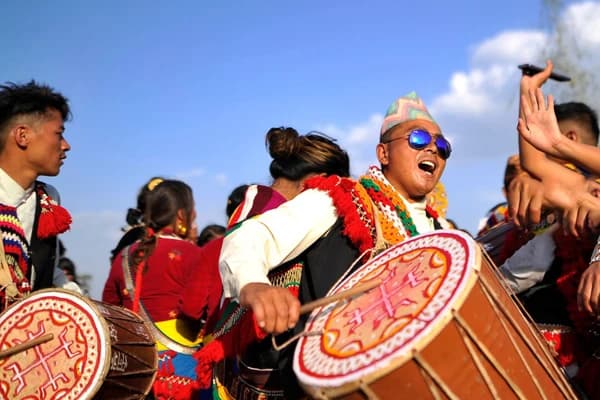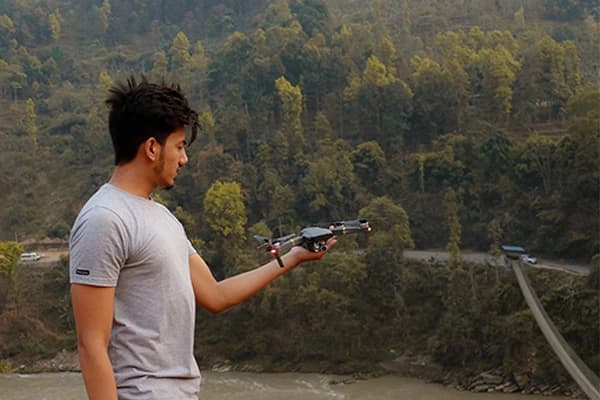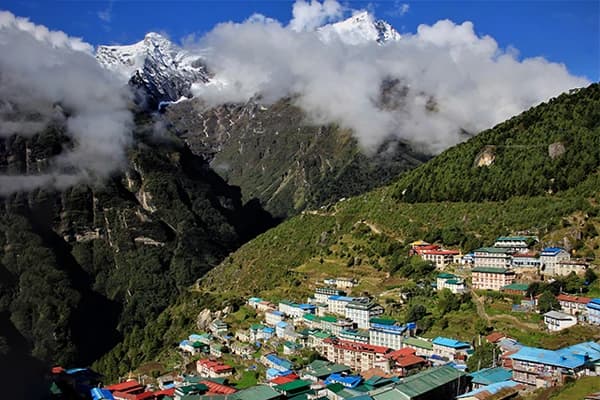Early medieval architectural complex of Panauti
Panauti is a sacred town located in the Kavrepalanchok District in the Bagmati Province of Nepal. It is situated at the junction of the Roshi River and Punyamati River. It bears importance for both Hindu and Buddhist pilgrimage and holds numerous cultural and religious heritages.
The Indresvar Mahadev Temple and the Brahmayani Temple are some of the popular architectural gems of this town. Panauti is famous for the invention of Nepali delicacy, Yomari. Yomari is made from rice flour which is made from steaming it by filling with molasses. It was listed in the tentative site in 1996.
Tilaurakot
Tilaurakot lies 24 km far from Lumbini. It is believed that Lord Gautam Budhha spent his royal childhood with his parents in this beautiful town. It also holds importance as the heart of the ancient Shakya city of Kapilvastu. It was listed in the tentative site in 1996.
After spending 29 years in the royal palace, he left his lavish life to reach enlightenment. The archaeological sites like the Western Gate, Central Structural Complex, Central Pond, Samai Mai Temple, The Eastern Gate, The Fortification Wall, The Northern Twin Stupa, Eastern Stupa and Monastery, and The Southern Industrial Mound are also quite famous. Besides Buddhism, Hindu temples and shrines hold great importance.
Enigmatic Cave architecture of Muktinath Valley in Mustang
Mustang, a windy savaged place is home to one of the world’s great archaeological mysteries. There are more than 10,000 human-built caves which makes it popular as the “Sky caves” of Nepal. The kingdom of Lo has transformed these burial caves into meditation chambers, military lookouts, and storage units.
There are valuable Buddhist paintings, sculptures, manuscripts, and artifacts which are believed to be thousands of old. You can visit these historically important places when you book the package for the Upper Mustang trek. In 1996, it was listed as a tentative site for UNESCO.
Medieval palace complex of Gorkha
Gorkha Palace complex was built by the King of Gorkha Ram Shah in the 16th century. Gorkha Durbar is a masterwork of Newari Architecture and serves as a fort, palace, and temple. The 1500 steps to the hilltop of the palace provide a spectacular view of the Manaslu, Annapurna, and Ganesh Himalayas. It was listed as a tentative UNESCO site in 1996.
After the coronation ceremony of Prithvi Narayan Shah as the king of Gorkha, he successfully different states as a unified Nepal. The palace was severely damaged by the massive earthquake in April 2015 but it has been reconstructed as of now. It also serves as the starting point of the Manaslu circuit trekking.
Ramagrama, the relic stupa of Lord Buddha
Ramagrama is one of the eight stupas that has relic remains of Lord Gautam Buddha. It is located in the Nawalparasi district of Nepal. The stupa lies in between the farmland and is covered by wetlands which were believed to have been constructed more than 2500 years ago.
It is not open as of now and was once visited by the Mauryan emperor, Ashoka in 249 BC. There is a belief that a snake god appeared in front of Ashoka when he tried to open the stupa and after that, no one dared to open it. In 1996, it was enlisted by UNESCO as a tentative cultural site.
The vernacular village of Khokana
Khokana is a small and historic Newari village which lies 8km south of Kathmandu valley. It was the first place to receive electricity in Nepal. The medieval settlement of Newar is composed of drainage, traditional houses, chaityas, a mother deity temple, and its mustard fields, processing sites, and chowks.
The word Khokana is derived from the Newari word “Khona” which means “narrating while shedding tears.” The Khokana village is popular for its mustard oil production and has some surviving works from the Kirat era. The locals use a traditional oil mill with two large wooden pieces to crush the roasted mustard seeds and extract oil.
The oil extracted from this method is filled with aroma that can be smelled far away. It is slowly replaced by modernization. There was a popular saying that if you ever smell mustard oil, you are in Khokhana.
Besides this, it is widely popular for the five-day Khokana Jatra. Masked dancer do their scary dance throughout the entire streets of the village which is annually celebrated in October. It was enlisted as a UNESCO tentative site in 1996.
Medieval walled city of Lo Manthang
Lo Manthang is the capital city of the former forbidden Kingdom of Lo. It was constructed in the 14th century and is situated 3800 m above sea level. Previously, it was the center of the ancient Tibet-Nepal salt trade that runs along the Kali Gandaki River.
The Upper Mustang was restricted to foreigners until 1992 and as of now, only limited tourists can visit this secluded city. The untouched city of modernization has preserved its way of life throughout the century. The six-meter-high earthen wall with a square tower or dzong on the corner encircles this secluded city.
The walls are carved with monuments that link to the monasteries and palaces of the Tibetan culture from the 15th and 18th centuries. An ethnic tribe named “Lhobas” are the inhabitants of the Lo Manthang. They are of western and central Tibetan and follow the same ancient festivals, rituals, and ceremonies.
Lo Manthang offers Gompas, the Royal Palace, narrow streets, and traditional houses infront of the mysterious mountain and caves. The popular tourist attractions of the Lo Manthang are the Chosar caves, Kali Gandaki gorge flowing from the caves, sky caves, Choede gompa, Tsarang gompa, mani wall, and earthy hues of mud sculptures. It was enlisted as a cultural tentative site for UNESCO in 2008. You can consider participating in the Upper Mustang Jeep tour and Mustang Tiji Festival tour with us.
Vajrayogini and the early settlement of Sankhu
Sankhu is located 17 km far from Kathmandu. It is an ancient Newar town which is also anointed as the 80 Siddhas where many caves hold religious importance. The town is famous for the Vajrayogini Temple and the former Lichhavi settlements (9th Century).
They follow traditional practices where medieval characters can be seen along the streets of the town and retain their medieval character with narrow streets, public squares, temples, and rest houses. Vajrayogini temple is famous as the Tantrik temple in the Gun Bihar Area and you can read about the chronological development of the temple in a religious book written in the Newari language. There are nine caves on the premises of the temple with a unique statue.
There is also a popular belief that Goddess Vajrayogini has a blessing to Manjushree to cut the lake and turn it into a valley. The main Vajrayogini temple has two sacred statues of the four armed Vajrayogini Ugra-tara who is worshipped by both Hindu and Buddhist devotees. The existence of this temple is living proof that Buddhism existed in Nepal around the first century.
The early settlement of Sankhu is related to the Monument zones of the Kathmandu Valley World Heritage sites culturally and historically. The famous festival Vajrayogini Fair on Chaite Purnima, is the full moon night of March or April according to the Georgian calendar. In 2008, it was listed as a tentative site for UNESCO.
Medieval Settlement of Kirtipur
Kirtipur lies on a double hillock in the Southwest part of the Kathmandu Valley. It is the oldest settlement with ancient and historical significance out of a total of five municipalities of Kathmandu Valley. Kirtipur word comes from the Sanskrit words Kriti and Pur which refer to the city of glory.
Kirtipur was a territory of Lalitpur and it was invaded by Prithvi Narayan Shah on his third attempt at unification in the 18th century. The city is famous for its Newar monuments like Chilancho Vihar, Jagat Pal Vihar, Buddha Dharma Sangha Shikhara, Baghbhairab Temple, Vath (Layaku), Umamaheshvar Temple, Indrayani Pith, Chitu Bahail, Lokeshwar Shikhara, Buddha Temple, Chve Bahal and Kwe Bahal. The locals are from the Newari settlement which is also popular as the center of Newari culture.
This historical city offers many cultural, natural, historical, and religious things such as old shrines and temples, traditional dress, beautiful landscape, a nearby hill, and so on. It is a place where Manjushree cut the pond from “Chovar Danda”, to drain out the water. Popular places to visit in this area are Panga, Chovar, Salyanthan, Taudaha Kauniachaur, and GodamChaur.
Taudaha Lake was created by Manjushree to provide shelter for snakes that used to stay in the pond before they turned into Kathmandu Valley. There is a huge crowd of worshippers on the occasion of Naag Panchami.
Bagh Bhairav Jatra is a popular festival celebrated in Kirtipur. Some of the highlights of the city are BaghBhairav, ChilanchuVihara, Uma Maheshwar Temple, LohanDehar, and Main Square. It was listed as a tentative UNESCO site in 2008.
Rishikesh Complex of Ruru Kshetra
The Rishikesh Complex of Ruru Kshetra was listed in tentative UNESCO in 2008. The ancient sacred Hindu site is well preserved and lies in the Palpa district of Nepal. The unique style of architecture and religious importance of the site have grabbed the attention of devotees all around the nation. The site connects famous pilgrimage sites Muktinath and Damodar Kunda via a cremation site.
It is located at the junction of two mountain streams Ridhi Khola and the Kali Gandaki River. It is also known as the Banaras of Nepal. The Ruru Kshetra offers many temples but Rishikesh is the most popular one. There is a saying that the King of Palpa discovered Lord Rishikesh while making his holy dip in the Kali Gandaki River.
The settlements near these holy sites have successfully protected the medieval character and architecture which makes its historic significance over the centuries. It holds a beautiful story of the sanctity of Ridi and its origin. When Devdutta, a Brahmin meditated to repent of his sinful act, Lord Indra sent one of the angels to bewitch him and destroyer his meditation with her beauty.
Later, the Brahmin married the angel, Pramalocha, and gave birth to a daughter. The abandoned daughter, Ruru was raised by a kin of a deer. Ruru meditated for many years and received the blessing of Lord Vishnu.
Lord Vishnu also manifested in a huge shaligram shila and named the place after Ruru. Rishikesh means the controller of sense in the form of Vishnu. The major festivals of this place are Maghe Sankranti and Ridi while Bhrigutungeshwar Cave, Saugadha Bihar, and Galful Caves are the popular attraction.
Nuwakot Palace
Nuwakot holds significant importance in the history of Nepal and intricate carvings, thick stone walls, a Palace, and temples made it one of the popular tourist destinations in Nepal. The word Nuwakot is made of “Nawa” which means nine and “Kort” which refers to sacred religious sites on the hilltop. It is also known as the “City of Nine Hills”.
The nine hills of the district are believed to be the residences of deities that protect the region. The Nuwakot Palace was built in the Malla style of architecture in the 18th century where you can see the remnant of the unification campaign of King Prithvi Narayan Shah. It has seven storied which is known as “Saat Talle Durbar”.
The Rangamahal lies in the southeast of the main palace and is made of oily bricks. It was built as a recreational place for the three kings of the Kantipur valley. Likewise, the Bhairab temple is also a famous shrine of the fort. The intricate carving, thick stone walls, and ornate temples make it a must-visit destination. Locals celebrate festivals like BhairabiJatra or SindureJatra, Narayan Jatra, GaiJatra, ShipaiJatra, Devi Jatra, Lakhe dance, Fulpati, Krishna Janmashtami, and others. It was listed as the tentative site in 2008.
Ram Janaki Temple
Ram Janaki temple is a sacred Hindu site that is famous as the birthplace of Goddess Sita. It lies in the Jankapur district and is one of the biggest temples in Nepal. Janakpur is situated in the Dhanusa district, Eastern Terai, and is the third largest city in the Terai region.
When a saint, Sannyasi Shukishordas plowed his land, he found a golden statue of the Goddess Sita in 1657. Then, it eventually became a religious site for the Janaki temple and temples were built in Hindu and Koiri-style architecture. Queen Tikamgarh, Vrish Bhanu supervised the construction of a temple in 1910.
It was built in full bright white color of Mughan and Koiri style and spans an area of 4,860 square feet. The three-storied temple is made of stones and marble and has 60 rooms decorated with the flag of Nepal, colored glass, engravings, and paintings, with beautiful lattice windows and turrets. King Janak used to rule Videha during the Ramayana era and he chose Lord Ram as his daughter Janaki(Sita) swayambar.
Then, Goddess Janaki became the queen of Ayodhya. The religious and historical linkage, made Ram Janaki temple listed on the tentative list of UNESCO World Heritage Sites. Ram Mandir lies a few meters away from Janaki Mandir and was built by General Amar Singh Thapa in the 17th century.
It was made in Pagaoda style and receives numerous pilgrimages on the occasion of Ram Navami and Dashain. The city hosts more than 200 sacred ponds for sacred baths, some of them are Ganga Sagar and Dhanush Sagar. Sankatmochan Mandir, Bhootnath Mandir, and Rajdevi Mandir. The popular festivals of Janakpur city are Nawami, Vivah Panchami, Dashain, Tihar, and Chhath.
Medieval Town of Tansen
Tansen is located at the magnificent hill station in Palpa district. The town is famous for its unique traditional wood carving skills and traditional woven Dhaka fabric i.e. “ Palpali Dhaka Topi”. The city lies in the Mahabharat Range of the Kali Gandaki River and has an elevation of 250 m to 2000m.
Tansen is the administrative city of Palpa and is a hidden gem of western Nepal. The town was a part of Bara Magarat around the 11th century. It was 12 territories ruled by Magar rulers.
It was a town for trading where Newar businessmen used to go to Tansen for trade while taking art and architecture. The city is believed as the living heritage and architecture of the Newari people. The city boasts a variety of temples, monasteries, sculptures, and architecture from the medieval settlement.
Rani Mahal holds the perfect example of the art and architecture of the city while reflecting the medieval period via carving and interiors. It is also known as the “ Taj Mahal of Nepal.” You can see a glimpse of medieval settlement in religious places like the Bhairab Temple, the Purankot Durbar, the Srinagar Durbar (Fort), the BanshaGopal, the Mukundeshwar Mahadev, the Amar Narayan Temple, the Ran-Ujjeshwari Bhagawati Temple, and the Tansen Durbar. It was listed in teh tentative UNESCO site in 2008.
Sinja Valley
Sinja Valley is the place where the Nepali language originated and is located in Jumla district. It has amazing archeological evidence of the medieval period and was one of the ancient Kingdoms of Nepal. The “Khas” language was originated from Sinja Valley.
During the 12th and 14th centuries, the valley was known as Khasa Kingdom or Malla Kingdom. One can see the earliest Devnagari script on the cliffs and nearby Dullu which dates back to the 13th century. The remains of ancient palaces, temples, and old settlements are taken to the Department of Archeology and Cambridge University by excavation.
Earthen pipes excavated testify that a water supply system was present back in the medieval period as well. The caves with ancient votive Buddhist Chaityas and cliff inscriptions are visible around the periphery of the Hima River. You can visit the wooden King and Queen Bridge full of wood carvings inside the valley. The off-beaten trail with natural and cultural significance was listed as a tentative world heritage site in 2008.
Bhurti Temple Complex of Dailekh
The Bhurti Temple Complex is located in the Bheri Zone of mid-west Nepal in the Dailekh district. The Bhurti temple complex is composed of 22 monuments with unique architecture. The 22 monuments are pillar structure monuments and were built in typical Western-style Malla architecture.
There is a mystery behind the age of the temple and who built it but its extrinsic stonework in Pachadeval style made it a popular travel destination. As of now, this temple complex hasn’t been worshipped and its originality is still preserved. The temple complex is similar structure of Sinja Valley and Dullu which marks the Khasa Kingdom. The artistic masterpiece and cultural heritage made it listed as a tentative site for UNESCO World Heritage in 2008.





